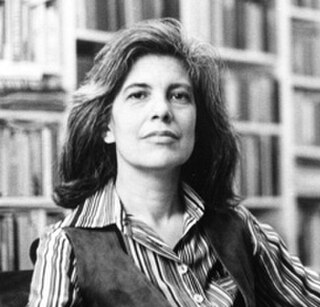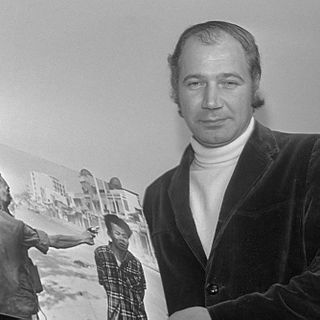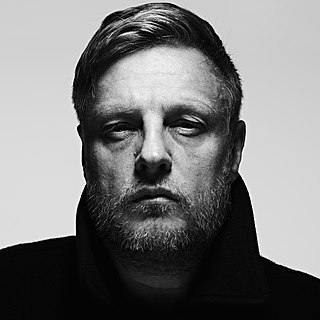Related Research Articles

Bainbridge is a city in Decatur County, Georgia, United States. The city is the county seat of Decatur County. As of the 2020 census, the city had a population of 14,468.

William Bainbridge was a Commodore in the United States Navy. During his long career in the young American Navy he served under six presidents beginning with John Adams and is notable for his many victories at sea. He commanded several famous naval ships, including USS Constitution, and saw service in the Barbary Wars and the War of 1812. Bainbridge was also in command of USS Philadelphia when she grounded off the shores of Tripoli in North Africa, resulting in his capture and imprisonment for many months. In the latter part of his career he became the U.S. Naval Commissioner.

Susan Sontag was an American writer, filmmaker, philosopher, teacher, and political activist. She mostly wrote essays, but also published novels; she published her first major work, the essay "Notes on 'Camp'", in 1964. Her best-known works include the critical works Against Interpretation (1966), Styles of Radical Will (1968), On Photography (1977), and Illness as Metaphor (1978), as well as the fictional works The Way We Live Now (1986), The Volcano Lover (1992), and In America (1999).

Photojournalism is journalism that uses images to tell a news story. It usually only refers to still images, but can also refer to video used in broadcast journalism. Photojournalism is distinguished from other close branches of photography by having a rigid ethical framework which demands an honest but impartial approach that tells a story in strictly journalistic terms. Photojournalists contribute to the news media, and help communities connect with one other. They must be well-informed and knowledgeable, and are able to deliver news in a creative manner that is both informative and entertaining.

William Eugene Smith was an American photojournalist. He has been described as "perhaps the single most important American photographer in the development of the editorial photo essay." His major photo essays include World War II photographs, the visual stories of an American country doctor and a nurse midwife, the clinic of Albert Schweitzer in French Equatorial Africa, the city of Pittsburgh, and the pollution which damaged the health of the residents of Minamata in Japan. His 1948 series, Country Doctor, photographed for Life, is now recognized as "the first extended editorial photo story".

Mathew Benjamin Brady was one of the earliest photographers in American history. Best known for his scenes of the Civil War, he studied under inventor Samuel F. B. Morse, who pioneered the daguerreotype technique in America. Brady opened his own studio in New York City in 1844, and photographed Andrew Jackson, John Quincy Adams, and Abraham Lincoln, among other public figures.

Gordon Roger Alexander Buchanan Parks was an American photographer, musician, writer and film director, who became prominent in U.S. documentary photojournalism in the 1940s through 1970s—particularly in issues of civil rights, poverty and African-Americans—and in glamour photography.

Roger Fenton was a British photographer, noted as one of the first war photographers.
Street photography, also sometimes called candid photography, is photography conducted for art or enquiry that features unmediated chance encounters and random incidents within public places. Although there is a difference between street and candid photography, it is usually subtle with most street photography being candid in nature and some candid photography being classifiable as street photography. Street photography does not necessitate the presence of a street or even the urban environment. Though people usually feature directly, street photography might be absent of people and can be of an object or environment where the image projects a decidedly human character in facsimile or aesthetic.

Edward Thomas Adams was an American photographer and photojournalist noted for portraits of celebrities and politicians and for coverage of 13 wars. He is best known for his photograph of the summary execution of Nguyễn Văn Lém, a Viet Cong prisoner, for which he won the Pulitzer Prize for Spot News Photography in 1969. Adams was a resident of Bogota, New Jersey.

War photography involves photographing armed conflict and its effects on people and places. Photographers who participate in this genre may find themselves placed in harm's way, and are sometimes killed trying to get their pictures out of the war arena.

Linda Wolf is an American photographer and author. She is one of the first female rock and roll photographers. Wolf also makes fine art photography with an emphasis on women and global photojournalism.

John Rankin Waddell, known mononymously as Rankin, is a British photographer and director who co-founded Dazed & Confused magazine. He is known for his photography of models including Kate Moss and Heidi Klum, and of celebrities such as Madonna, David Bowie and Elizabeth II. His work has appeared in magazines including GQ, Vogue and Marie Claire.
George Georgiou is a freelance British photographer and photojournalist best known for his work in eastern Europe, particularly Turkey.

Stephen Decatur Jr. was a United States naval officer and commodore. He was born on the eastern shore of Maryland in Worcester County. His father, Stephen Decatur Sr., was a commodore in the United States Navy who served during the American Revolution; he brought the younger Stephen into the world of ships and sailing early on. Shortly after attending college, Decatur followed in his father's footsteps and joined the U.S. Navy at the age of nineteen as a midshipman.

John Cyril "Jack" Cato, F.R.P.S. was a significant Australian portrait photographer in the Pictorialist style, operating in the first half of the twentieth century. He was the author of the first history of Australian photography; The Story of the Camera in Australia (1955)
Anthony Hernandez is an American photographer who divides his time between Los Angeles, his birthplace, and Idaho. His photography has ranged from street photography to images of the built environment and other remains of civilization, particularly those discarded or abandoned elements that serve as evidence of human presence. He has spent most of his career photographing in Los Angeles and environs. "It is L.A.'s combination of beauty and brutality that has always intrigued Hernandez." La Biennale di Venezia said of Hernandez, "For the past three decades a prevalent question has troubled the photographer: how to picture the contemporary ruins of the city and the harsh impact of urban life on its less advantaged citizens?" His wife is the novelist Judith Freeman.

The Southwest Georgia Regional Library (SWGRL) is a public library system serving the counties of Decatur, Miller, and Seminole, Georgia. The central library is the Gilbert H. Gragg Library located in Bainbridge, Georgia.

David Lebe is an American photographer. He is best known for his experimental images using techniques such as pinhole cameras, hand-painted photographs, photograms, and light drawings. Many of his photographs explore issues of gay identity, homoeroticism, and living with AIDS, linking his work to that of contemporaries such as Robert Mapplethorpe, Peter Hujar, and David Wojnarowicz. Though his style and approach set him apart from these contemporaries, "Lebe is now incontrovertibly part of the history of twentieth-century queer artists."
Mark Ruwedel is an American landscape photographer and educator. Ruwedel has written: "I am interested in revealing the narratives contained within the landscape, especially those places where the land reveals itself as being both an agent of change and the field of human endeavour." He has made work depicting evidence of human presence in remote, barren and desert regions of North America, predominantly in black and white.
References
- ↑ One Place, p. 8.
- ↑ "One Place: A Look at Decatur County, Georgia – Garden & Gun".
- ↑ Rankin, Tom; Hill, Iris Tillman (2013). One Place: Paul Kwilecki and Four Decades of Photographs from Decatur County, Georgia. ISBN 978-1469607405.
- ↑ This summary relies on Tom Rankin’s introduction in One Place. Rankin also presents Kwilecki’s life and work in videotaped lectures at the Library of Congress (https://www.loc.gov/today/cyberlc/feature_wdesc.php?rec=6199) and the Decatur Book Festival (https://vimeo.com/136145232).
- ↑ "Interview With Paul Kwilecki (Bainbridge, Georgia, 12/28/94) / Paul Kwilecki Photographs / Duke Digital Repository". Duke Digital Collections. Retrieved 2018-08-09.
- ↑ Rankin, One Place, pp. 9-11. The letters exchanged by Vestal and Kwilecki are available at Duke University’s Rubenstein Library, along with an extensive collection of Kwilecki’s journals, correspondence, and dark room notes. See https://repository.duke.edu/dc/kwilecki and https://library.duke.edu/rubenstein/findingaids/kwileckipaul/.
- ↑ This summation derives from a collection of exhibit brochures, newspaper and magazine articles, letters, and drafts of talks in the possession of Paul Kwilecki’s daughter Susan Kwilecki.
- ↑ Interview with Paul Kwilecki (Bainbridge, Georgia, 12/28/94) at https://repository.duke.edu/dc/kwilecki/kwlpw03001; see also the video at https://vimeo.com/181089719/3a68ee2db3.
- ↑ DuBois Gallery Curator Ricardo Viero’s interview with Kwilecki, Lehigh University, 1994 exhibit brochure, Susan Kwilecki’s collection.
- ↑ “Duke Talk: October 2001.” Manuscript in Susan Kwilecki’s collection.
- ↑ See the court house photographs in One Place, pp. 114-124 and 240-249.
- ↑ One Place, p. 115.
- ↑ “SPE Talk, A talk to be given to the Society for Photographic Education, Atlanta, GA, November 5, 1994.” Manuscript in Susan Kwilecki’s collection.
- ↑ See selections from the Junior-Senior series in One Place, pp. 229-234.
- ↑ One Place, p. 228.
- ↑ Pictures of this baptism are in One Place, pp. 175-177.
- ↑ One Place, p. 174.
- ↑ Rankin, Tom; Hill, Iris Tillman (2013). One Place: Paul Kwilecki and Four Decades of Photographs from Decatur County, Georgia. ISBN 978-1469607405.
- ↑ Photographs of the bridges are in One Place, pp. 209-211.
- ↑ In One Place, Rankin uses pictures of the statue editorially, pp. 79, 89, 113, 133, 195, 207, and 251.
- ↑ Interview with Paul Kwilecki (Bainbridge, Georgia, 12/28/94) at https://repository.duke.edu/dc/kwilecki/kwlpw03001.
- ↑ See the selections from the Battles’ Quarters series in One Place, pp. 64-74.
- ↑ One Place, p. 71.
- ↑ One Place, 19f.
- ↑ Lowly Wise, pp. 46, 48. Pictures of Mt. Horum are on pp. 18-23; the photograph of the First Baptist Church is on p. 13. See the selections from the religion series in One Place, pp. 170-185.
- ↑ One Place pp. 2-8. In a quotation on the One Place book jacket, Sandra S. Phillips, photography curator of the San Francisco Museum of Modern Art, also depicts Kwilecki as, like his impoverished subjects, an “outsider himself, at least by temperament.”
- ↑ One Place, p. 40.
- ↑ Interview with Paul Kwilecki (Bainbridge, Georgia, 12/28/94) at https://repository.duke.edu/dc/kwilecki/kwlpw03001. For a selection of photographs from the shade tobacco series, see One Place, pp. 49-63.
- ↑ “Duke Talk: October 2001.” Manuscript in Susan Kwilecki’s collection.
- ↑ Interview with Paul Kwilecki (Bainbridge, Georgia, 12/28/94) at https://repository.duke.edu/dc/kwilecki/kwlpw03001.